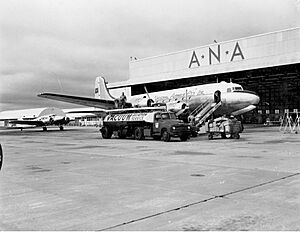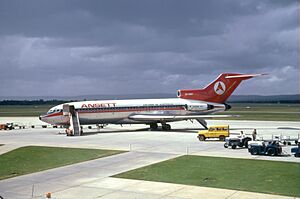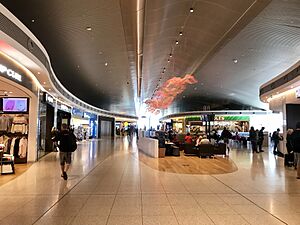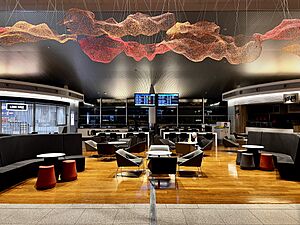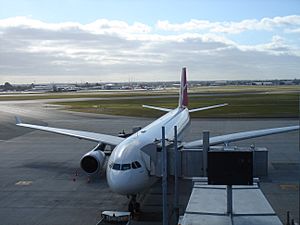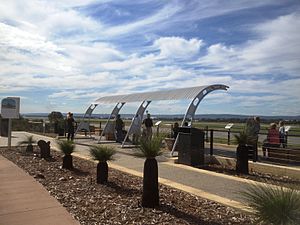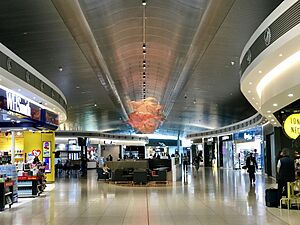Perth Airport facts for kids
Quick facts for kids
Perth Airport
|
|||||||||||||||
|---|---|---|---|---|---|---|---|---|---|---|---|---|---|---|---|
 |
|||||||||||||||

Terminal 1 in 2015
|
|||||||||||||||
| Summary | |||||||||||||||
| Airport type | Public | ||||||||||||||
| Owner | Utilities Trust of Australia (38%) Future Fund (30%) |
||||||||||||||
| Operator | Perth Airport Pty Ltd | ||||||||||||||
| Serves | Perth Metropolitan Region | ||||||||||||||
| Location | Perth Airport | ||||||||||||||
| Hub for | |||||||||||||||
| Focus city for | |||||||||||||||
| Elevation AMSL | 67 ft / 20 m | ||||||||||||||
| Coordinates | Lua error in Module:Coordinates at line 614: attempt to index field 'wikibase' (a nil value). | ||||||||||||||
| Map | |||||||||||||||
| Lua error in Module:Location_map at line 416: Malformed coordinates value. | |||||||||||||||
| Runway | |||||||||||||||
|
|||||||||||||||
| Statistics (YE Jun-Oct 2023) | |||||||||||||||
|
|||||||||||||||
Perth Airport (IATA: PER, ICAO: YPPH) is a big airport in Perth, the main city of Western Australia. It handles flights that go to other countries, within Australia, and smaller private planes.
It is the fourth busiest airport in Australia for how many people travel through it. The airport is located across parts of the City of Belmont, City of Kalamunda, and the City of Swan. Perth Airport and Jandakot Airport (another airport nearby) had over 362,000 planes take off or land in 2017.
Perth Airport covers a huge area of 2,105 hectares (about 5,202 acres). Since 1997, a company called Perth Airport Pty Ltd has managed it under a long 99-year lease from the Australian Government.
Contents
- Where is Perth Airport Located?
- How Perth Airport Has Grown
- A Look Back at Perth Airport's History
- Airport Terminals and Services
- Airlines and Where They Fly
- Airport Operations and Passenger Numbers
- Getting To and From the Airport
- Airport Incidents and Safety
- What's Next for Perth Airport?
- Images for kids
- See also
Where is Perth Airport Located?
Perth Airport is about 10 kilometers (6 miles) east of the main city area of Perth. It is one of three airports for regular flights in the Perth area. The others are Jandakot Airport and Rottnest Island Airport.
There are also two military airfields near Perth. RAAF Base Pearce is about 30 kilometers (19 miles) north. The other is part of HMAS Stirling on Garden Island, about 42 kilometers (26 miles) southwest.
Perth Airport is on the traditional land of the Whadjak-Noongar Aboriginal people.
How Perth Airport Has Grown
From 2000 to 2012, more and more people used Perth Airport. This was mainly because of a big mining boom in Western Australia. Also, more international airlines started offering cheaper flights.
By June 2012, the number of international passengers grew by 11.7%, and domestic passengers by 6.9%. Overall, passenger numbers went up by 10.3%. In just 10 years, from 2002 to 2012, the number of travelers tripled to over 12.6 million people.
After 2012, the mining boom slowed down. This meant fewer people traveled within Australia. However, more international flights kept the airport busy.
A Look Back at Perth Airport's History
The Beginning of the Airport
Before Perth Airport opened, planes used to land at Maylands Aerodrome or even on the city's foreshore at Langley Park. But by the late 1930s, Maylands Aerodrome was too small for the newer, faster planes. So, they needed a new place for an airport.
In 1938, land was bought for the new airport in an area then called Guildford. This land was once a golf course. A plaque at the old International terminal remembers John Scott, who first owned this land.
Military Use During World War II
Even before regular flights started, World War II began. The airport was then used by the Royal Australian Air Force and United States Navy. It was called "RAAF Station Guildford" and helped out RAAF Base Pearce.
Despite being a military base, civilian airlines like Qantas Empire Airways and Australian National Airways (ANA) started flying from here in 1944. This was because the larger planes they used couldn't land at Maylands. ANA flew the first commercial flight from Guildford to Adelaide.
Early Civilian Flights
Regular civilian flights began at Guildford Aerodrome in 1944. The old Maylands airport closed in 1963.
At first, Guildford Aerodrome was very basic. It had a small control tower and buildings left over from the war. Boarding a plane was like getting on a bus because there weren't many passenger facilities.
In 1948, MacRobertson Miller Airlines (MMA) moved to Guildford. Then, Trans Australia Airlines (TAA) started flying from there in December 1948. The airport became very busy with cargo flights, moving fresh food and goods across Australia.
In September 1952, the airport was given "international" status. In March 1953, it was officially renamed Perth Airport. A new international terminal was being built using recycled materials from military buildings. On this day, Qantas also started its "Wallaby service" from Sydney to South Africa, stopping in Perth.
The Jet Age Arrives
By the mid-1950s, not many people flew. But as planes got faster and more advanced, the airport also improved. In the mid-1960s, Perth Airport started seeing its first domestic jet planes, like the Boeing 727 and Douglas DC-9.
Perth Airport was one of the few big airports in Australia that didn't have a curfew. This meant planes could fly at any time, even late at night. This led to "the midnight horror" or "red-eye special" flights, which are now called red-eye flights.
New Terminals are Built
In 1960, the old international terminal was taken apart and moved to Cannington. This made space for a new building that would combine both domestic and international flights.
In 1962, airlines moved into this new combined terminal. It was opened just in time for the busy 1962 British Empire and Commonwealth Games. This new terminal was located where Terminals 3 and 4 are today.
Building the International Terminal
By 1971, when the huge Boeing 747 planes started arriving, the single terminal was too small. More space was needed for the growing number of passengers.
In 1980, plans were made to build a new international terminal. Construction began in March 1984. The road leading to it, Horrie Miller Drive, was named after a local aviation pioneer, Horrie Miller.
The new International Terminal opened on October 25, 1986. The control tower built at the same time was the tallest in Australia. This terminal could handle up to five Boeing 747 planes every hour.
Changes from 1988 Onwards

In the late 1980s, the government created the Federal Airports Corporation (FAC) to manage airports like Perth. Later, in July 1997, Perth Airport Pty Ltd took over the management with a 99-year lease.
Airlines like Qantas and Ansett built their own new domestic terminals on the northern side of the airport. After Ansett stopped flying in 2001, its terminal became a multi-user terminal for other airlines. Today, the old International terminal is called Terminal 1 International, and the Ansett terminal is Terminal 1 Domestic. The Qantas terminals are now Terminals 3 and 4.
From 2003 to 2006, the International terminal was updated with more shops and better baggage systems.
In 2004, the airport celebrated its 60th birthday and opened a new taxiway for larger planes like the Airbus A380. The Airbus A380 first visited Perth Airport in 2008.
In 2012, a report said Perth Airport was the worst in Australia for airlines. But after many upgrades, it was named the best airport in Australia for service quality in 2018.
Terminal 2 opened on February 28, 2013, mainly for regional flights. In September 2024, domestic Jetstar flights moved to T2.
In April 2015, work started on a $42 million upgrade to the front of Terminal 1. This was finished in November 2016. In May 2015, Emirates started using the Airbus A380 for flights to Perth from Dubai.
On November 22, 2015, the domestic part of Terminal 1 opened. It became the main home for Virgin Australia flights.
On May 15, 2016, the world's largest cargo plane, the Antonov An-225 Mriya, landed at Perth Airport for the first time.
A new train line to the airport started being built on November 3, 2016. The Airport line opened on October 9, 2022. It connects the airport to the city's train network. There is also a "skybridge" connecting the train station to Terminal 1.
On December 11, 2016, Qantas announced non-stop flights from Perth to London Heathrow using Boeing 787 Dreamliners. To do this, Terminals 3 and 4 were upgraded for international flights. Flights to London started in March 2018. In June 2022, Qantas also started direct flights to Rome, and will start flights to Paris in July 2024.
In May 2018, Qatar Airways also started using the Airbus A380 for their Perth-Doha service.
In May 2024, it was announced that Terminals 3 and 4 will get upgrades. Also, Qantas and Jetstar will move to a new terminal in the Airport Central area by 2031. This will cost about $5 billion AUD and include a new runway.
Airport Terminals and Services
Perth Airport has five terminals: four main ones and one smaller one.
- On the eastern side (where the future main terminal will be):
- Terminal 1 (T1) is for international flights. It has jetways and gates for large planes like the Boeing 777 and Airbus A380. It also has airline lounges for Emirates, Singapore Airlines, Air New Zealand, and Aspire. A new domestic section opened in 2015 for Virgin Australia flights.
- Terminal 2 (T2) is next to T1 and is mostly for regional flights. Virgin Australia Regional and Alliance Airlines use it. Jetstar domestic flights also moved here in September 2024. It has an Alliance lounge.
- On the western side (these terminals will be replaced in the future):
- Terminal 3 (T3) has jetways and gates. It is used by Qantas for both domestic and international flights. It has customs and immigration facilities and two Qantas lounges.
- Terminal 4 (T4) is only for domestic flights by Qantas and QantasLink. It has check-in for Qantas international flights and two Qantas lounges.
- There is also a General Aviation terminal north of T3 and T4. It is used by charter planes and for mining companies.
Runways for Planes
The airport has two runways. The main one, 03/21, is 3,444 meters (11,299 feet) long. The other, 06/24, is 2,163 meters (7,096 feet) long.
In 1965, the main runway was made longer to fit Boeing 707 planes. In 2005, the cross runway was rebuilt and made stronger for large planes like the Airbus A380.
Weather Services
Weather services for Perth Airport started in 1944. Now, all weather operations are done from a new office in Belmont.
Viewing Areas
There are two places where you can watch planes at Perth Airport. Terminal 1 has an Observation Deck on Level 3. It has vending machines and flight information screens.
The second viewing area is on Dunreath Drive, near Runway 03. It has a shelter shaped like a Boeing 747 and displays about aviation history.
Other Services at the Airport
Perth Airport offers free Wi-Fi at Terminals 1, 2, and 3. Terminal 4 also has free Wi-Fi from Qantas.
Airlines and Where They Fly
Perth Airport has 30 airlines flying to over 50 places in Australia, Asia, Africa, and Europe. Each week, there are 1258 domestic and regional flights, and 213 international flights.
Passenger Flights
| Airlines | Destinations |
|---|---|
| AirAsia | Kuala Lumpur–International |
| AirAsia X | Kuala Lumpur–International |
| Air Mauritius | Mauritius |
| Air New Zealand | Auckland |
| Airnorth | Alice Springs Seasonal: Darwin, Kununurra |
| Alliance Airlines | Kalgoorlie, Newman, Port Hedland Charter: Barimunya, Cape Preston, Christmas Creek, Christmas Island, Coondewanna, Karratha, Leinster, Leonora, Mount Keith, Paraburdoo, Telfer, The Granites |
| All Nippon Airways | Seasonal: Tokyo–Narita |
| Batik Air | Denpasar, Jakarta–Soekarno-Hatta |
| Batik Air Malaysia | Denpasar, Kuala Lumpur–International |
| Cathay Pacific | Hong Kong |
| China Eastern Airlines | Seasonal: Shanghai–Pudong |
| China Southern Airlines | Guangzhou (resumes 28 November 2024) |
| Citilink | Denpasar |
| Emirates | Dubai–International |
| Indonesia AirAsia | Denpasar |
| Jetstar | Adelaide, Bangkok–Suvarnabhumi, Brisbane, Cairns, Denpasar, Gold Coast, Melbourne, Phuket, Singapore, Sydney |
| Malaysia Airlines | Kuala Lumpur–International |
| Maroomba Airlines | Charter: Dalgaranga, Golden Grove, Mount Magnet |
| National Jet Express | Charter: Barrow Island, Cue, Jundee, Karara, Laverton, Leinster, Leonora, Meekatharra, Mount Keith, Murrin Murrin, Newman, Nova, Plutonic, Tropicana |
| Nexus Airlines | Geraldton |
| Philippine Airlines | Manila |
| Qantas | Adelaide, Alice Springs, Brisbane, Broome, Canberra, Darwin, Kalgoorlie, Karratha, London–Heathrow, Melbourne, Newman, Paris–Charles de Gaulle, Port Hedland, Singapore, Sydney Seasonal: Rome–Fiumicino Charter: Christmas Creek, Cloudbreak, Ginbata, Solomon |
| QantasLink | Broome, Darwin, Exmouth, Geraldton, Kalgoorlie, Karratha, Newman, Onslow, Paraburdoo, Port Hedland Charter: Carosue Dam, Christmas Creek, Cloudbreak, Eliwana, Ginbata, Iron Bridge, Koolan Island, Solomon, Wodgina |
| Qatar Airways | Doha |
| Rex Airlines | Albany, Carnarvon, Esperance, Monkey Mia |
| Scoot | Singapore |
| Singapore Airlines | Singapore |
| Skippers Aviation | Charter: Burnakura, Darlot-Centenary, Jundee, Kalbarri, Laverton, Lawlers, Leinster, Leonora, Meekatharra, Mount Magnet, Plutonic, Sunrise Dam, Wiluna |
| South African Airways | Johannesburg–O.R. Tambo |
| Thai Airways International | Bangkok–Suvarnabhumi |
| VietJet Air | Ho Chi Minh City |
| Vietnam Airlines | Ho Chi Minh City |
| Virgin Australia | Adelaide, Brisbane, Broome, Cairns, Darwin, Hobart, Kalgoorlie, Karratha, Kununurra, Melbourne, Newman, Port Hedland, Sydney Seasonal: Launceston |
| Virgin Australia Regional Airlines | Adelaide, Broome, Christmas Island, Cocos (Keeling) Islands, Darwin, Hobart, Kalgoorlie, Karratha, Kununurra, Onslow, Port Hedland Charter: Argyle, Barimunya, Barrow Island, Boolgeeda, Busselton, West Angelas, Woodie Woodie |
Cargo Flights
| Airlines | Destinations |
|---|---|
| Qantas Freight | Adelaide, Hong Kong, Melbourne |
| Qatar Airways Cargo | Doha |
Airport Operations and Passenger Numbers
The total number of passengers at Perth Airport has grown by about 2.5% each year since 1998. In 2022, 78% of all travelers were on domestic flights within Australia.

| Year | Domestic | International | Total | Change |
|---|---|---|---|---|
| 1998 | 3,235,524 | 1,434,077 | 4,669,601 | |
| 1999 | 3,257,087 | 1,474,898 | 4,731,985 | |
| 2000 | 3,463,122 | 1,580,622 | 5,043,744 | |
| 2001 | 3,341,803 | 1,587,379 | 4,929,182 | |
| 2002 | 3,371,315 | 1,636,422 | 5,007,737 | |
| 2003 | 3,892,623 | 1,586,622 | 5,479,245 | |
| 2004 | 4,437,291 | 1,827,389 | 6,264,680 | |
| 2005 | 4,754,672 | 2,007,025 | 6,761,697 | |
| 2006 | 5,429,870 | 2,034,877 | 7,464,747 | |
| 2007 | 6,105,246 | 2,373,568 | 8,478,814 | |
| 2008 | 6,705,180 | 2,533,022 | 9,238,202 | |
| 2009 | 6,841,037 | 2,774,737 | 9,615,774 | |
| 2010 | 7,319,853 | 3,133,709 | 10,453,562 | |
| 2011 | 8,016,032 | 3,349,468 | 11,365,500 | |
| 2012 | 8,999,571 | 3,618,768 | 12,618,339 | |
| 2013 | 8,981,872 | 3,919,840 | 12,901,712 | |
| 2014 | 8,758,519 | 4,180,407 | 12,938,926 | |
| 2015 | 8,401,532 | 4,192,833 | 12,594,365 | |
| 2016 | 8,125,486 | 4,379,175 | 12,504,661 | |
| 2017 | 7,985,065 | 4,385,467 | 12,370,532 | |
| 2018 | 8,111,748 | 4,365,971 | 12,477,719 | |
| 2019 | 8,150,336 | 4,363,180 | 12,513,516 | |
| 2020 | 2,947,118 | 978,960 | 3,926,078 | |
| 2021 | 3,854,138 | 90,651 | 3,944,789 | |
| 2022 | 6,539,200 | 1,871,003 | 8,410,203 | |
| 2023 | 8,278,831 | 3,885,836 | 12,164,667 | |
| February 2024 | 350,387 |
Busiest Domestic Routes
| Rank | Airport | Passengers | % change |
|---|---|---|---|
| 1 | Melbourne | 1,347,836 | |
| 2 | Sydney | 1,118,846 | |
| 3 | Brisbane | 737,276 | |
| 4 | Karratha | 491,859 | |
| 5 | Adelaide | 486,279 | |
| 6 | Port Hedland | 448,166 | |
| 7 | Broome | 392,148 | |
| 8 | Newman | 341,794 | |
| 9 | Kalgoorlie | 301,881 | |
| 10 | Darwin | 149,938 | N/A |
Busiest International Routes

| Rank | Airport | Passengers handled | % Change |
|---|---|---|---|
| 1 | Singapore | 1,331,516 | |
| 2 | Denpasar | 947,382 | |
| 3 | Kuala Lumpur | 615,027 | |
| 4 | Doha | 319,987 | |
| 5 | Dubai | 296,036 | |
| 6 | Auckland | 217,024 | |
| 7 | Hong Kong | 131,562 | |
| 8 | London | 123,968 | |
| 9 | Jakarta | 105,254 | |
| 10 | Mauritius | 62,742 |
Getting To and From the Airport
By Road
You can get to Terminals 1 and 2 using Tonkin Highway and Airport Drive. To reach Terminals 3 and 4, use Tonkin Highway, Dunreath Drive, and Brearley Avenue, or Great Eastern Highway and Fauntleroy Avenue.
Transperth buses connect the terminals to train stations. Route 292 connects Terminals 3 and 4 to Redcliffe railway station. Route 37 connects Terminals 1 and 2 to Oats Street railway station. There is also a bus that takes you between the T1/T2 and T3/T4 areas. Many hotels also offer private bus services.
Several car rental companies are at the airport. All terminals have special areas for taxis and rideshare services.
By Train
The Airport Central Station is about 250 meters (820 feet) from Terminals 1 and 2. It offers underground train services on the Transperth network's Airport line. The station opened on October 9, 2022. It is connected to Terminal 1 by a covered walkway.
The closest train station to Terminals 3 and 4 is Redcliffe Station, also on the Airport line, about 980 meters (3,215 feet) away. Passengers can take bus route 292 from Terminals 3 and 4 to Redcliffe Station.
Airport Incidents and Safety
Incidents During Construction
On April 13, 1987, a helicopter was helping to put a light on top of the control tower. The helicopter's hook got caught, causing it to crash. The pilot sadly died.
Past Plane Crashes (Not at Airport)
- On July 2, 1949, a plane called Fitzroy crashed about a mile north of the airport shortly after taking off. All 18 people on board died.
- On June 26, 1950, a plane called Amana crashed near York, Western Australia, 22 minutes after leaving Perth Airport. 28 of the 29 people on board died. This was one of Australia's worst plane accidents.
Emergency Landing Options
If bad weather or fog affects Perth Airport, planes can land at other emergency airports. These include Learmonth Airport, Adelaide Airport, Cunderdin Airport, Kalgoorlie-Boulder Airport, and Busselton Margaret River Airport.
Other Incidents at the Airport
In April 2020, Perth Airport staff used vehicles to block some Virgin Australia planes. This was because the airline reportedly owed money.
In May 2024, a problem with refueling caused at least 70 flights to be canceled, delayed, or sent to other airports.
On September 15, 2024, Runway 03 was damaged after a Qantas Airbus A330 took off. No one was hurt, but the runway was badly damaged.
What's Next for Perth Airport?
Combining Terminals
The plan is to bring all domestic and international flights into one main terminal area on the eastern side of the airport. This big project includes expanding Terminal 1 and building a new terminal for Qantas. The goal is to finish this by 2031.
A Third Runway
A new runway is planned to be built. It will be 3,000 meters (9,843 feet) long and run next to the current main runway. Perth Airport hopes to open this new runway by 2028.
Other Future Plans
Perth Airport also plans to build a 250-room hotel and a multi-story car park next to the Airport Central Station. Construction for the new car park started in mid-2024 and should be finished by 2026. The roads in front of Terminals 1 and 2 will also be updated.
Images for kids
-
A Qantas Airbus A330-300 docked at Terminal 1. Terminals 3 and 4 are visible in the background.
-
An AirAsia X aircraft at Perth Airport
-
Afternoon lineup at Perth Airport (from front to back): Emirates Airbus A380, Scoot Boeing 787, Air New Zealand Boeing 787, Qatar Airways Boeing 777
See also
 In Spanish: Aeropuerto de Perth para niños
In Spanish: Aeropuerto de Perth para niños



